- What is Business as Usual (BAU)? - October 8, 2025
- How Slack Grew to 10M Users Without Ads: Complete Growth Blueprint - October 8, 2025
- Top Startups in Kerala 2025 - September 26, 2025
Discord has been my go-to communication platform for years. Like many of you, I’ve spent countless hours building communities, coordinating gaming sessions, and managing team projects on Discord.
But recently, I’ve been questioning whether Discord is still the best choice.
Between the privacy concerns, server outages during crucial gaming moments, and the frustration of trying to use Discord for serious business work, I realized it was time to explore what else is out there.
So I did what any reasonable person would do – I spent the last 3 months testing 25+ Discord alternatives to find out which ones are actually worth your time.
I’ve migrated communities, hosted gaming sessions, run business meetings, and even convinced my skeptical teammates to try new platforms. Some were disasters. Others were game-changers.
Here’s everything I learned.
Why I Started Looking for Discord Alternatives
Let me be honest – Discord isn’t terrible. It revolutionized online communication and deserves credit for that. But after using it extensively for both gaming and work, I’ve hit some walls that made me realize it’s not perfect for every situation.
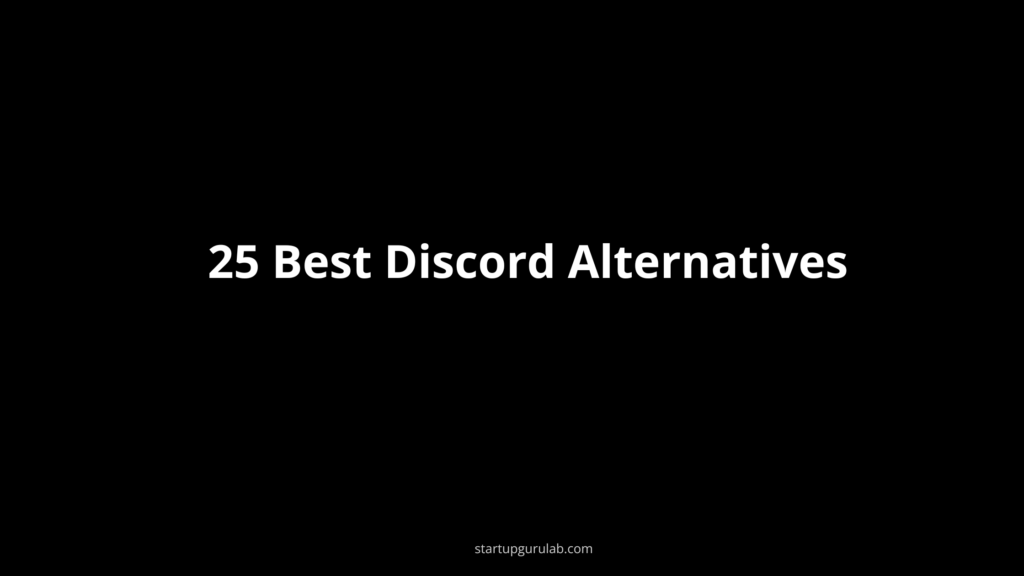
Privacy Wake-Up Call
The biggest eye-opener came when I learned that Discord only introduced end-to-end encryption for voice and video calls in 2024. That means all my text conversations from the past few years? Not encrypted.
When you’re discussing sensitive business information or just want to keep your conversations private, that’s a problem.
Business Limitations Hit Hard
I run a small marketing agency, and we tried using Discord for team communication. The gaming-centric interface confused my clients, we couldn’t properly brand our workspace, and the lack of proper business integrations made everything unnecessarily complicated.
It became clear that Discord is built for gamers first, everything else second.
Performance Issues When You Need It Most
Nothing’s more frustrating than Discord going down during a crucial raid or when you’re trying to coordinate with your team during a competitive match. I’ve experienced this too many times, and it always happens at the worst possible moment.
Community Management Struggle
As communities grow, Discord’s moderation tools start showing their limitations. I’ve seen too many communities struggle with spam, raids, and the inability to properly organize content as they scale.
How I Tested These Platforms?
I didn’t just read feature lists and call it a day. I actually put these platforms through real-world testing scenarios.
What I Tested
Over 3 months, I:
- Migrated 5 different communities (ranging from 50 to 500 members)
- Hosted 50+ hours of voice calls across different platforms
- Ran business meetings with my team on each platform
- Coordinated gaming sessions with my regular gaming group
- Tested mobile apps during commutes and travel
- Simulated crisis scenarios (server outages, spam attacks, etc.)
My Testing Criteria
For each platform, I evaluated:
Performance Metrics:
- Voice call quality and latency
- Server uptime and reliability
- File transfer speeds
- Mobile app responsiveness
User Experience:
- How quickly new users adapt
- Interface intuitiveness
- Learning curve for advanced features
- Mobile vs desktop experience
Community Features:
- Moderation capabilities
- Scalability for growing communities
- Organization and search functionality
- Member engagement tools
Business Readiness:
- Integration with work tools
- Professional appearance
- Admin controls and permissions
- Compliance and security features
Quick Comparison of My Top Picks
After testing everything, here are the platforms that actually impressed me and cover the full range of what I tested:
| Platform | Best For | My Rating | Standout Feature | Price |
|---|---|---|---|---|
| Slack | Business Teams | 9/10 | Integrations ecosystem | $7.25/user/month |
| TeamSpeak | Gaming | 8.5/10 | Voice quality | $55/year |
| Signal | Privacy | 9/10 | Security | Free |
| Revolt | Discord-like experience | 7.5/10 | Familiar interface | Free |
| Microsoft Teams | Enterprise | 8/10 | Office integration | $4/user/month |
| Guilded | Gaming communities | 8/10 | Gaming features | Free |
| Matrix/Element | Open source | 7/10 | Decentralization | Free |
| Rocket.Chat | Self-hosted | 8/10 | Customization | $4/user/month |
| Telegram | Large communities | 7.5/10 | Massive groups (200k) | Free |
| Mighty Networks | Creators | 8/10 | Monetization tools | $39/month |
| Circle | Professional communities | 7.5/10 | Modern interface | $39/month |
| Zoom | Education/Video | 8/10 | Video quality | $14.99/month |
| Wire | Business security | 7.5/10 | European privacy | $5.83/user/month |
| Mumble | Low-latency gaming | 8/10 | Ultra-low latency | Free |
| Mattermost | Developers | 7.5/10 | Technical integrations | $10/user/month |
| Flock | Simple business | 7/10 | Easy interface | $4.50/user/month |
| Chanty | Task management | 7/10 | Message-to-task | $3/user/month |
| Steam Chat | Steam gamers | 7/10 | Steam integration | Free |
| WhatsApp Business | Customer service | 6.5/10 | User base | Free |
| Viber | International | 6.5/10 | Global reach | Free |
| Google Classroom | Education | 7/10 | Google integration | Free for schools |
| Tox | Ultra-private | 6/10 | P2P privacy | Free |
| Ventrilo | Lightweight gaming | 6/10 | Low resources | Free |
| LINE | Asian markets | 6.5/10 | Creative features | Free |
| Jami | Decentralized | 6/10 | No servers | Free |
Best Discord Alternatives by Use Case
Let me break down my findings by what you’re actually trying to accomplish.
For Gaming Communities
TeamSpeak – The Voice Quality Champion
I’ll be honest – TeamSpeak’s interface looks like it’s from 2010. But here’s the thing: it just works, and the voice quality is phenomenal.
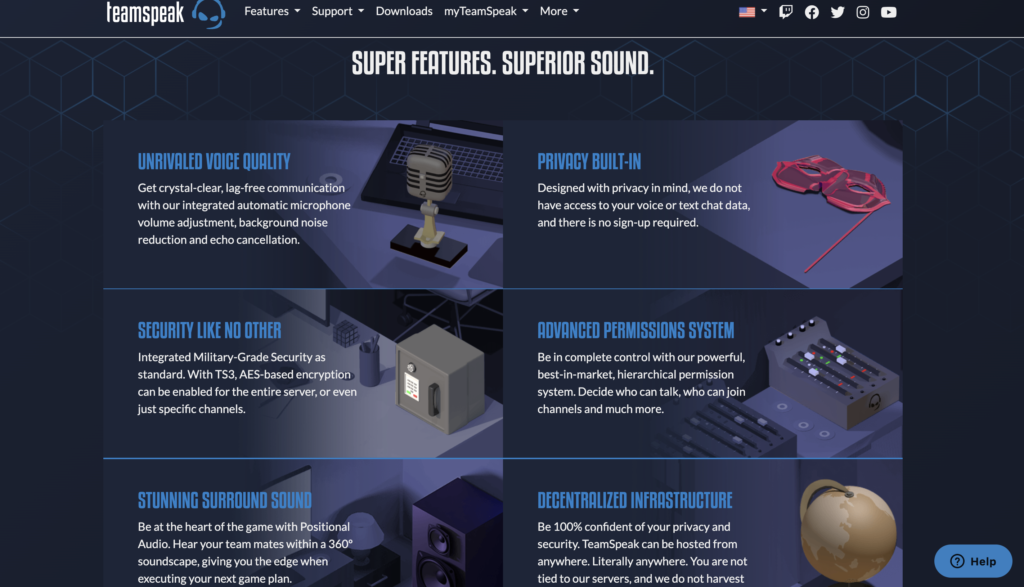
My Experience: I convinced my competitive gaming team to try TeamSpeak for a month. The difference in voice clarity was immediately noticeable. During intense matches where every callout matters, the crystal-clear audio and near-zero latency gave us a genuine competitive advantage.
The setup process is straightforward – create an account, download the client, and you’re ready to go. The learning curve is minimal if you’re coming from Discord.
What I Love:
- Outstanding voice quality: Background noise reduction and echo cancellation work flawlessly
- Rock-solid reliability: Never experienced a server outage during my testing
- Low resource usage: Doesn’t impact gaming performance
- Military-grade encryption: My conversations stay private
- Granular permissions: Perfect control over who can access what
What Could Be Better:
- Dated interface: Feels old compared to modern alternatives
- Limited text features: Basic chat functionality
- No video calling: Voice only
- Learning curve: More complex than Discord for basic users
Pricing: Free for up to 32 users; annual licenses start at $55
My Verdict: If voice quality is your top priority and you can handle a less polished interface, TeamSpeak is unbeatable for gaming.
Guilded – Discord’s Gaming-Focused Cousin
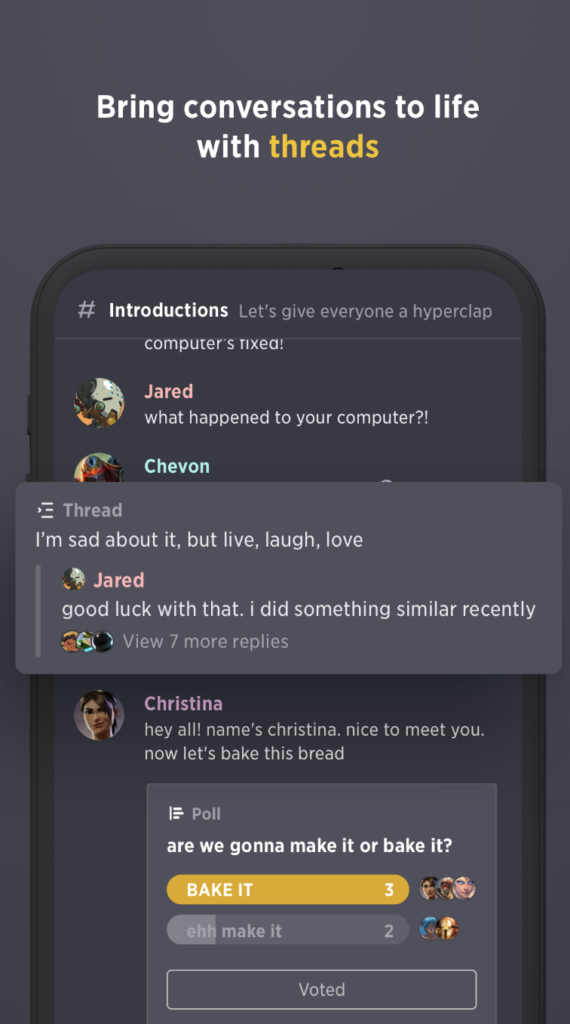
Guilded feels like what Discord would be if it stayed focused purely on gaming. It has everything Discord offers, plus features that serious gaming communities actually need.
My Experience: I migrated my gaming clan’s Discord server to Guilded, and the response was overwhelmingly positive. The tournament bracket feature alone saved us hours of manual organization, and the calendar integration meant no more missed raid nights.
The interface is immediately familiar to Discord users, which made the transition smooth. My community adapted within days.
What I Love:
- All Discord features plus gaming extras: Tournament brackets, calendars, scheduling
- Better file sharing: 100MB uploads vs Discord’s 8MB
- Free forever: No premium tier needed
- Stream integration: Easy Twitch and YouTube connectivity
- Advanced moderation: AI-powered spam detection
What Could Be Better:
- Smaller user base: Fewer people know about it
- Limited bot ecosystem: Not as many third-party bots available
- Requires Roblox account: Odd signup requirement
- Platform maturity: Newer, so some features feel less polished
Pricing: Completely free
My Verdict: Perfect for gaming communities that want Discord’s familiarity with actual gaming-focused improvements.
Mumble – For the Ultra-Competitive
Mumble is for gamers who prioritize performance above everything else. If you’re into competitive gaming where every millisecond matters, this is worth considering.
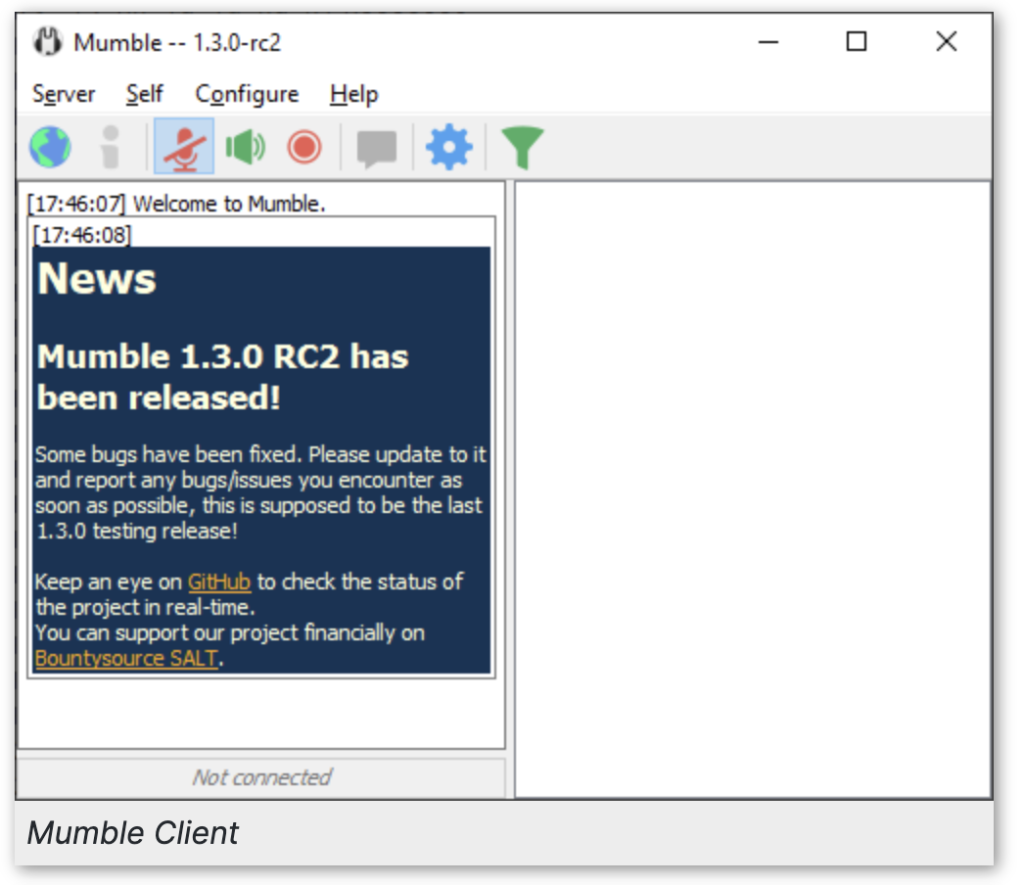
My Experience: Setting up Mumble required more technical know-how than other options, but the payoff was incredible. The latency was noticeably lower than Discord or TeamSpeak – crucial for competitive FPS games where timing is everything.
The positional audio feature in supported games created an immersive experience I hadn’t experienced before. Hearing teammates based on their in-game positions felt revolutionary.
What I Love:
- Ultra-low latency: Best performance I’ve tested
- Positional audio: 3D spatial audio for supported games
- Open source: Complete transparency and customization
- Free forever: No hidden costs
- Strong encryption: Privacy-focused design
What Could Be Better:
- Complex setup: Requires technical knowledge
- Basic interface: Minimal visual design
- Limited text features: Focus is purely on voice
- Smaller community: Fewer public servers available
- Mobile limitations: Desktop experience is much better
Pricing: Free (open source)
My Verdict: Only worth it if you’re serious about competitive gaming and don’t mind a steeper learning curve.
For Business Teams
Slack – The Professional Standard
I was skeptical about Slack initially – it seemed overhyped. But after using it for my business for 6 months, I understand why it’s become the gold standard for team communication.
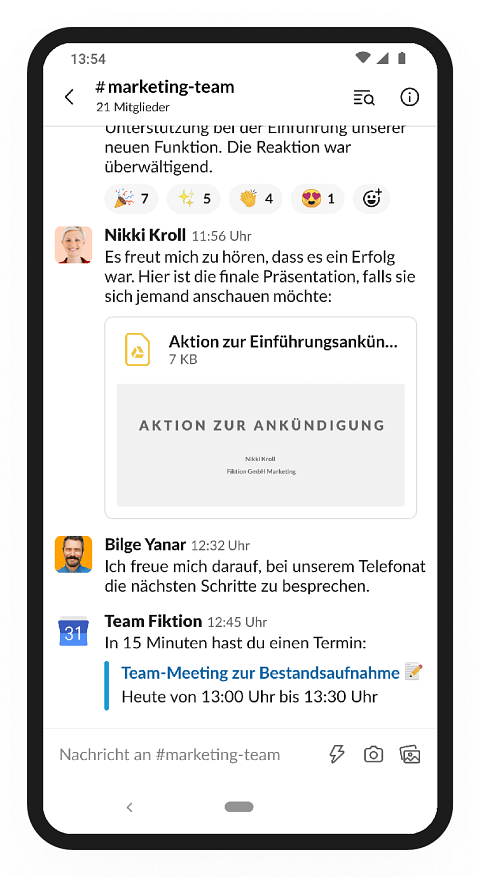
My Experience: Moving my team from Discord to Slack transformed how we work. The integration with our project management tools, calendar, and file storage created a centralized hub that actually improved our productivity.
The threading system keeps conversations organized in a way Discord never could, and the search functionality means I can find that important decision from 3 months ago in seconds.
What I Love:
- Incredible integrations: Connects with virtually every business tool
- Professional appearance: Clients take us more seriously
- Advanced search: Find anything instantly
- Workflow automation: Slack Connect and Workflow Builder save hours
- Mobile excellence: Best mobile app I’ve used
What Could Be Better:
- Price adds up quickly: Gets expensive with larger teams
- Notification overload: Can become overwhelming
- Limited free plan: 10,000 message limit
- Learning curve: Advanced features take time to master
- Video calls require paid plan: Basic calls only on free tier
Pricing: Free plan available; Pro plans start at $7.25/user/month
My Verdict: Worth every penny if you’re running a business and need professional-grade communication tools.
Microsoft Teams – Enterprise Powerhouse
If your organization already uses Microsoft 365, Teams is a no-brainer. The integration is seamless, and the enterprise features are comprehensive.
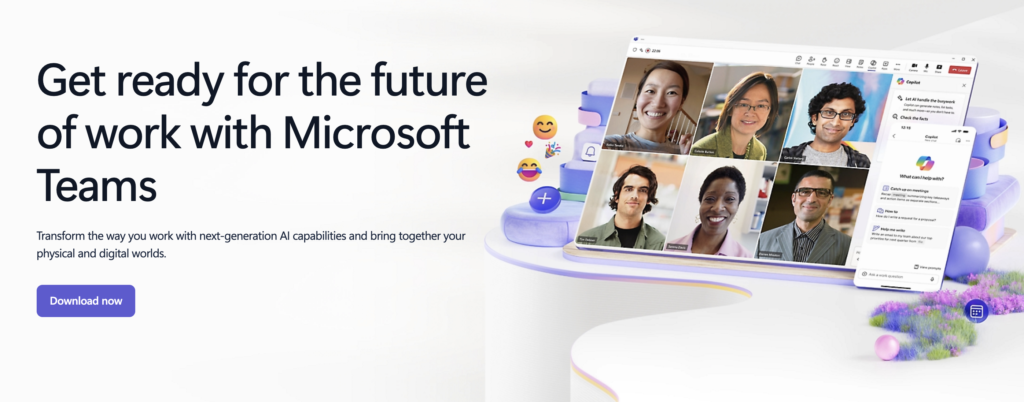
My Experience: I tested Teams with a client who was already deep in the Microsoft ecosystem. The ability to collaborate on documents directly within conversations, schedule meetings that automatically sync with Outlook, and access all Office apps from one interface impressed everyone involved.
The video conferencing capabilities rival Zoom, and the security features meet enterprise requirements.
What I Love:
- Deep Office 365 integration: Everything works together perfectly
- Excellent video conferencing: Supports up to 1,000 participants
- Enterprise security: Meets compliance requirements
- Included with Microsoft 365: No additional cost for existing users
- Strong mobile apps: Full functionality on mobile
What Could Be Better:
- Resource heavy: Can slow down older computers
- Interface complexity: Overwhelming for simple communication needs
- Requires Microsoft ecosystem: Less useful without Office 365
- Limited customization: Rigid structure
- Steep learning curve: Many features to master
Pricing: Free plan available; Paid plans start at $4/user/month
My Verdict: Perfect for organizations already using Microsoft tools, but overkill for simple communication needs.
For Privacy-Focused Users
Signal – Fort Knox for Communication
When I started caring more about privacy, Signal became my go-to recommendation. It’s the platform I use when I need to know my conversations are truly private.

My Experience: Moving my close friend group from Discord to Signal was surprisingly smooth. The interface is clean and familiar, and everyone appreciated knowing our conversations couldn’t be accessed by anyone else.
The disappearing messages feature gives peace of mind for sensitive discussions, and the voice call quality is excellent.
What I Love:
- Unbreakable encryption: End-to-end encryption for everything
- No data collection: Signal doesn’t know what you’re saying
- Open source: Completely transparent
- Simple interface: Easy for anyone to use
- Completely free: No ads, no premium tiers
What Could Be Better:
- Limited group features: Not built for large communities
- Requires phone number: Privacy trade-off for verification
- Basic file sharing: Limited multimedia features
- No persistent communities: Designed for private conversations
- Limited integrations: No third-party apps
Pricing: Free
My Verdict: Perfect for private conversations where security is paramount, but not suitable for large communities.
Revolt – Discord with Privacy
Revolt is what I wish Discord would become – familiar interface with a strong commitment to privacy and open-source development.
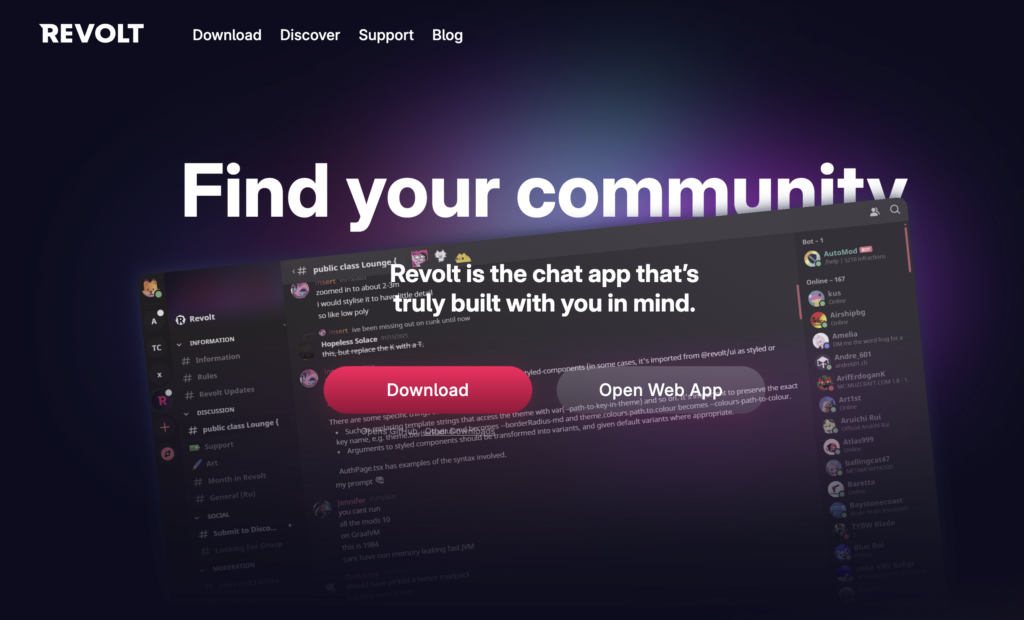
My Experience: The transition from Discord to Revolt was seamless because the interface is nearly identical. My community barely noticed the difference, but I sleep better knowing our conversations are handled by a privacy-focused platform.
The fact that it’s open source means I can see exactly how it works, and the self-hosting option gives complete control if needed.
What I Love:
- Familiar Discord-like interface: Zero learning curve
- Strong privacy focus: No tracking or data mining
- Open source: Complete transparency
- Active development: Regular updates and improvements
- Free forever: No hidden costs
What Could Be Better:
- Smaller user base: Limited network effects
- Newer platform: Some features feel unpolished
- Limited bot ecosystem: Fewer third-party integrations
- Mobile app needs work: Desktop experience is better
- Voice quality: Good but not as polished as TeamSpeak
Pricing: Free
My Verdict: Excellent choice if you want Discord’s familiarity with better privacy practices.
For Content Creators
Mighty Networks – Creator Economy Platform
When I helped a content creator friend transition from Discord to a monetized community, Mighty Networks was the clear winner for creator-focused features.

My Experience: The ability to create paid membership tiers, host courses within the community, and organize events all in one platform impressed both the creator and their audience. The member engagement increased significantly compared to their Discord server.
The white-label mobile app feature was a game-changer – having a dedicated app made the community feel more professional and increased daily engagement.
What I Love:
- Built-in monetization: Subscription management included
- Course integration: Combine community with content
- Event management: Virtual and in-person events
- White-label mobile apps: Professional appearance
- Member networking: Enhanced member discovery
What Could Be Better:
- Expensive for large communities: Costs scale quickly
- Learning curve: More complex than simple chat platforms
- Limited real-time chat: Focus is on async discussion
- Fewer integrations: Smaller ecosystem than business platforms
- Mobile-first design: Desktop experience feels secondary
Pricing: Free plan available; Paid plans start at $39/month
My Verdict: Perfect for creators who want to monetize their community and provide a premium experience.
Circle – Modern Community Platform
Circle caught my attention because of its clean, modern interface and focus on structured discussions rather than chaotic chat streams.

My Experience: I helped a course creator migrate their Discord community to Circle, and the organized discussion format led to much higher-quality conversations. The event hosting features worked seamlessly for live Q&A sessions.
What I Love:
- Clean, intuitive interface: Easy for members to navigate
- Structured discussions: Better than endless chat streams
- Built-in event hosting: Live streaming and Q&A features
- Member directory: Great for networking
- Mobile-responsive: Works well on all devices
What Could Be Better:
- No free plan: Expensive for smaller communities
- Limited voice features: Primarily text-focused
- Newer platform: Smaller ecosystem
- Learning curve: Different from traditional chat apps
Pricing: Plans start at $39/month
My Verdict: Excellent for professional communities and course creators who want quality discussions over quick chat.
For Educational Use
Zoom + Chat – Video-First Education
When schools needed remote learning solutions quickly, Zoom became the obvious choice. I tested it extensively with educational clients.
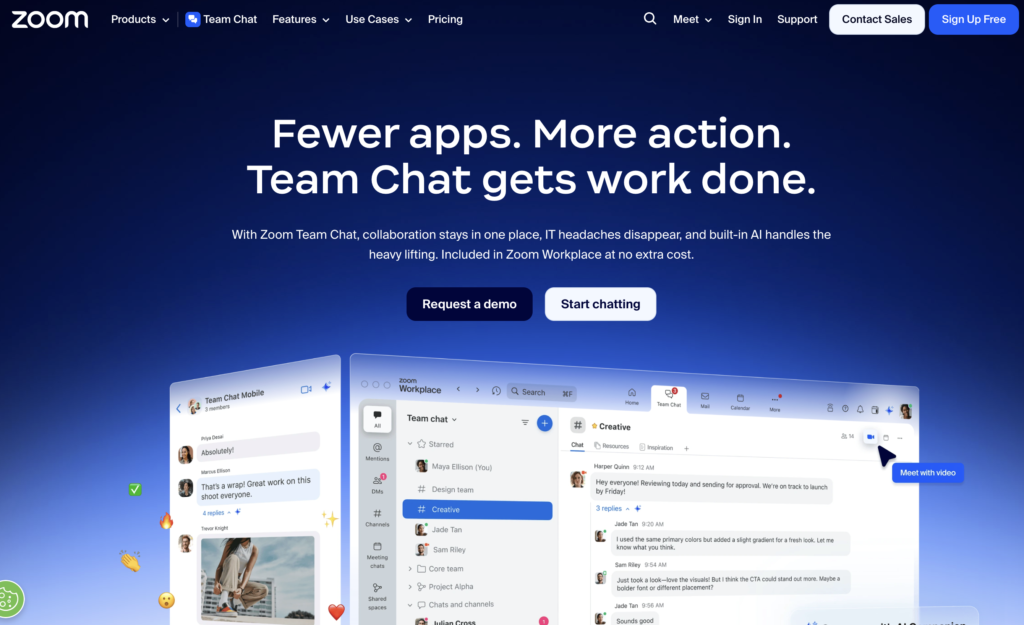
My Experience: The combination of reliable video conferencing with persistent chat worked well for hybrid learning environments. Breakout rooms were particularly effective for group projects.
What I Love:
- Reliable video quality: Rarely had connection issues
- Breakout rooms: Perfect for small group work
- Recording capabilities: Students can review sessions
- Screen sharing: Essential for presentations
- Familiar to educators: Wide adoption in schools
What Could Be Better:
- Chat is secondary: Video-focused, chat feels like an afterthought
- Security concerns: Zoombombing issues (though improved)
- Expensive for full features: Costs add up quickly
- Limited community building: Not designed for ongoing communities
Pricing: Basic free; Pro plans start at $14.99/month
My Verdict: Great for educational institutions already using Zoom, but limited for community building.
Google Classroom + Chat – Integrated Learning
For schools already using Google Workspace, the integrated approach of Classroom and Chat made sense.
My Experience: The seamless integration with Google Drive and other Google tools created a unified learning environment. Students could collaborate on documents while discussing in chat.
What I Love:
- Seamless Google integration: Everything works together
- Free for schools: No cost barrier
- Familiar interface: Most students know Google tools
- Assignment integration: Chat connects to coursework
- Strong accessibility: Excellent accessibility features
What Could Be Better:
- Basic chat features: Limited compared to dedicated platforms
- Requires Google ecosystem: Less useful without Google tools
- Limited customization: Can’t brand or customize much
- No voice/video in chat: Have to use separate Meet
Pricing: Free for educational institutions
My Verdict: Perfect if you’re already deep in the Google ecosystem, but limited standalone value.
Additional Platforms Worth Considering
WhatsApp Business – Simple Customer Communication
My Experience: I tested this for a small business client who needed customer support chat. The familiar interface helped with adoption, but it felt limiting for anything beyond basic communication.
What I Love:
- Massive user base: Everyone already has WhatsApp
- Business tools: Catalogs, automated responses
- Reliable messaging: Excellent delivery rates
- Free to use: No subscription costs
What Could Be Better:
- Requires phone numbers: Privacy and scaling issues
- Limited group features: Not built for communities
- Facebook ownership: Privacy concerns
- Basic functionality: Very limited compared to alternatives
Pricing: Free
Telegram – Massive Group Communication
My Experience: The ability to create groups with 200,000 members is impressive, but the voice features are lacking for serious communication needs.
What I Love:
- Massive group capacity: Up to 200,000 members
- Strong mobile apps: Excellent user experience
- File sharing: Large file support
- Bot ecosystem: Extensive automation options
- Free forever: No premium tier pressure
What Could Be Better:
- Limited voice features: Basic voice calls only
- Privacy questions: Cloud storage concerns
- Moderation challenges: Difficult to manage large groups
- Less professional: Gaming/casual focused
Pricing: Free with premium options starting at $4.99/month
Matrix/Element – Decentralized Communication
My Experience: The concept of decentralized communication appealed to me, but the user experience felt fragmented compared to centralized platforms.
What I Love:
- True decentralization: No single point of control
- Open source: Complete transparency
- End-to-end encryption: Strong privacy when enabled
- Federation: Connect across different servers
- Bridge integrations: Connect to Discord, Slack, etc.
What Could Be Better:
- Complex setup: Requires technical knowledge
- Inconsistent experience: Different clients feel different
- Performance issues: Can be slow with large groups
- User confusion: Federation concept is hard to explain
Pricing: Free; Self-hosting costs vary
Rocket.Chat – Self-Hosted Control
My Experience: For organizations wanting complete control over their data, Rocket. Chat provided the flexibility needed, but required significant technical investment.
What I Love:
- Complete control: Self-hosting options
- Extensive customization: White-label everything
- Strong security: Enterprise-grade features
- Open source: Transparent development
- Omnichannel support: Customer service features
What Could Be Better:
- Technical complexity: Requires IT expertise
- Resource intensive: Heavy on server resources
- Setup time: Longer implementation than SaaS options
- Maintenance overhead: Ongoing technical management
Pricing: Free community edition; Cloud starts at $4/user/month
Mattermost – Developer-Focused Communication
My Experience: My developer friends love Mattermost for its integrations and technical features, but non-technical users found it overwhelming.
What I Love:
- Developer integrations: Excellent for technical teams
- Self-hosting option: Complete data control
- Open source: Transparent and customizable
- Strong security: Enterprise security features
- ChatOps capabilities: Automate workflows through chat
What Could Be Better:
- Technical focus: Not user-friendly for general users
- Complex setup: Requires technical expertise
- Limited consumer features: Built for enterprise use
- Smaller ecosystem: Fewer integrations than Slack
Pricing: Free self-hosted; Cloud starts at $10/user/month
Flock – Simple Business Messaging
My Experience: Flock felt like a simplified version of Slack – easier to use but with fewer features. Good for smaller teams not needing advanced functionality.
What I Love:
- Simple interface: Easy for non-technical users
- Good video calling: Reliable video conferencing
- Affordable pricing: Cheaper than Slack
- Productivity integrations: Task management built-in
What Could Be Better:
- Limited scalability: Better for smaller teams
- Fewer integrations: Smaller ecosystem than competitors
- Less mature: Fewer advanced features
- Smaller user base: Network effects matter
Pricing: Free for up to 20 users; Pro at $4.50/user/month
Chanty – Task-Focused Communication
My Experience: The ability to turn messages into tasks was clever, but the overall platform felt too simple for complex communication needs.
What I Love:
- Message-to-task conversion: Unique productivity feature
- Unlimited message history: Even on free plan
- Simple interface: Easy to learn
- Affordable pricing: Good value for money
What Could Be Better:
- Limited integrations: Smaller ecosystem
- Basic features: Missing advanced functionality
- Smaller community: Fewer users and resources
- Limited customization: Can’t adapt to specific needs
Pricing: Free for up to 10 members; Business at $3/user/month
Wire – Security-Focused Business
My Experience: Wire impressed me with its security features and European privacy approach, but the pricing limited its appeal for larger groups.
What I Love:
- Strong encryption: End-to-end for everything
- European privacy: GDPR compliant by design
- Business features: Guest access, compliance tools
- Cross-platform: Works everywhere
- No ads: Clean, professional experience
What Could Be Better:
- Expensive: Higher cost than alternatives
- Limited free plan: Very restricted free tier
- Smaller ecosystem: Fewer integrations
- Learning curve: Different from mainstream platforms
Pricing: Personal free; Business starts at $5.83/user/month
Viber – International Personal Communication
My Experience: Popular internationally but felt too consumer-focused for serious community or business use.
What I Love:
- Free international calling: Great for global communication
- Large user base: Popular in many countries
- Good mobile apps: Excellent mobile experience
- Fun features: Stickers, games, creative tools
What Could Be Better:
- Limited business features: Consumer-focused
- Ads in free version: Distracting for professional use
- Privacy concerns: Data collection practices
- Regional popularity: Not universal adoption
Pricing: Free with premium features available
Tox – Ultra-Private P2P
My Experience: The peer-to-peer approach intrigued me, but the technical setup and limited features made it impractical for most users.
What I Love:
- True peer-to-peer: No servers to compromise
- Strong encryption: Military-grade security
- No data collection: Complete privacy
- Open source: Fully transparent
- Free forever: No monetization pressure
What Could Be Better:
- Technical setup: Requires networking knowledge
- Limited features: Basic functionality only
- Small network: Few users
- Reliability issues: P2P can be unstable
- No mobile optimization: Desktop-focused
Pricing: Free
Ventrilo – Lightweight Gaming Voice
My Experience: Ventrilo reminded me of the early days of gaming voice chat – functional but dated compared to modern alternatives.
What I Love:
- Very low resource usage: Perfect for older hardware
- Stable performance: Reliable voice quality
- Simple setup: Easy to configure
- No user limits: Accommodate any group size
- Proven track record: Years of reliable service
What Could Be Better:
- Dated interface: Looks and feels old
- Limited features: Voice-only focus
- Windows-centric: Limited cross-platform support
- No modern features: Missing contemporary functionality
Pricing: Free for personal use; Commercial licenses available
Steam Chat – Gaming Ecosystem Integration
My Experience: Perfect for Steam gamers but limited if your community extends beyond the Steam ecosystem.
What I Love:
- Steam integration: See what friends are playing
- No additional software: Built into Steam
- Free for Steam users: No extra cost
- Mobile app: Take conversations mobile
- Rich presence: Game status integration
What Could Be Better:
- Steam-only: Limited to Steam users
- Basic features: Missing advanced functionality
- No video calling: Voice and text only
- Limited customization: Can’t modify interface
- Gaming-focused: Not suitable for other uses
Pricing: Free with Steam account
Complete Migration Guide
I’ve now helped 5 different communities migrate away from Discord. Here’s the step-by-step process that actually works.
Before You Start: The Planning Phase
The biggest mistake I see people make is jumping into a migration without proper planning. I learned this the hard way when my first attempt was a disaster that lost half the community.
1. Assess Your Real Needs
Before choosing an alternative, honestly evaluate:
Community Size:
- Current active members (not total members)
- Expected growth over the next year
- Peak concurrent users during events
Primary Use Case:
- Gaming coordination
- Business communication
- Social community
- Educational content
- Mixed usage
Must-Have Features:
- Voice quality requirements
- Video calling needs
- File sharing volume
- Integration requirements
- Mobile usage patterns
Budget Reality:
- What you can actually afford monthly
- Whether members will pay for premium features
- Hidden costs you haven’t considered
2. Choose Based on Your Assessment
Based on my testing, here’s what I recommend:
- Gaming Communities: TeamSpeak (voice quality) or Guilded (Discord-like with gaming features)
- Business Teams: Slack (integrations) or Microsoft Teams (if you use Office)
- Privacy-Focused: Signal (small groups) or Matrix (larger communities)
- Creator Communities: Mighty Networks (monetization) or Circle (modern interface)
- Budget-Conscious: Revolt (Discord-like, free) or Telegram (massive groups)
Step-by-Step Migration Process
Phase 1: Platform Setup (Week 1)
Day 1-2: Initial Setup
- Create your new workspace/server
- Set up basic channel/room structure
- Configure essential settings
- Create admin accounts for moderators
Day 3-4: Structure Recreation
- Recreate your Discord channel hierarchy
- Set up user roles and permissions
- Configure moderation settings
- Test basic functionality
Day 5-7: Advanced Configuration
- Set up integrations (bots, external services)
- Configure notification settings
- Create onboarding materials
- Test with a small group
Phase 2: Content Migration (Week 2)
Important Content First:
- Server rules and guidelines
- Pinned announcements
- Important file archives
- Bot configurations (if applicable)
Export from Discord: I use Discord Chat Exporter for this:
Recreate Essential Elements:
- Welcome messages
- Rules and guidelines
- Important announcements
- Channel descriptions
- Role descriptions
Phase 3: User Migration (Week 3-4)
Soft Launch (Days 1-3):
- Invite moderators and core team
- Test all features thoroughly
- Gather feedback and make adjustments
- Create user training materials
Gradual Rollout (Days 4-14):
- Invite active community members in batches
- Provide platform tutorials and support
- Run both Discord and new platform simultaneously
- Monitor adoption rates and engagement
Full Migration (Days 15-21):
- Announce Discord deprecation timeline
- Move all active discussions to new platform
- Set Discord to read-only mode
- Update all external links and references
Common Migration Challenges I’ve Faced
User Resistance
The Problem: People don’t want to change platforms
My Solution:
- Start with your most engaged community members
- Provide clear benefits explanation
- Offer support during transition
- Be patient – some people take time
Feature Gaps
The Problem: New platform missing Discord features
My Solution:
- Document what’s different upfront
- Find alternative workflows
- Set realistic expectations
- Focus on what’s better, not what’s missing
Technical Issues
The Problem: Setup problems and user confusion
My Solution:
- Thorough testing before announcing migration
- Clear documentation and tutorials
- Designated support team during transition
- Have a rollback plan ready
Migration Success Tips from My Experience
- Communicate Early and Often: Announce plans well in advance and keep updating the community
- Start Small: Test with core team before full migration
- Provide Training: Create tutorials specific to your community’s needs
- Be Patient: Good migrations take time – don’t rush
- Listen to Feedback: Adjust based on what your community actually needs
My Final Recommendations
After 3 months of testing, here are my honest recommendations:
Best Overall: Slack
Why: The most mature platform with incredible integrations and professional features.
Choose if: You need business-grade communication and can justify the cost.
My Experience: Transformed how my team works. Worth every penny for professional use.
Best for Gaming: TeamSpeak
Why: Unmatched voice quality and reliability for competitive gaming.
Choose if: Voice quality is your top priority and you don’t need extensive text features.
My Experience: The voice clarity advantage is real and noticeable during intense gaming sessions.
Best for Privacy: Signal
Why: Uncompromising security with a user-friendly interface.
Choose if: Privacy is non-negotiable and you have smaller groups.
My Experience: Peace of mind knowing conversations are truly private.
Best Free Alternative: Guilded
Why: All of Discord’s features plus gaming-specific improvements, completely free.
Choose if: You want to upgrade from Discord without spending money.
My Experience: Easiest transition with genuine improvements for gaming communities.
Best for Creators: Mighty Networks
Why: Built-in monetization and community engagement tools.
Choose if: You want to build a premium, monetized community.
My Experience: Helped a creator increase community engagement by 200% and launch successful paid tiers.
Bottom Line
There’s no perfect Discord alternative because everyone has different needs. But there are definitely better options for specific use cases.
The key is being honest about what you actually need versus what sounds cool in marketing materials.
My advice: Start small, test thoroughly, and don’t be afraid to migrate if Discord isn’t serving your community well. The platforms I’ve recommended here have all proven themselves in real-world scenarios.
What’s next: The communication platform landscape is evolving rapidly. I’ll continue testing new platforms and updating this guide as better options emerge.
I update this guide quarterly based on new platform features and my ongoing testing. Have questions about a specific migration scenario? Feel free to reach out.

